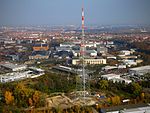Max Planck Institute for Evolutionary Anthropology
Max Planck Institute for Evolutionary Anthropology

The Max Planck Institute for Evolutionary Anthropology (German: Max-Planck-Institut für evolutionäre Anthropologie, shortened to MPI EVA) is a research institute based in Leipzig, Germany, that was founded in 1997. It is part of the Max Planck Society network. Well-known scientists currently based at the institute include founding director Svante Pääbo and Johannes Krause (genetics), Christophe Boesch (primatology), Jean-Jacques Hublin (human evolution), Richard McElreath (evolutionary ecology), and Russell Gray (linguistic and cultural evolution).
Excerpt from the Wikipedia article Max Planck Institute for Evolutionary Anthropology (License: CC BY-SA 3.0, Authors, Images).Max Planck Institute for Evolutionary Anthropology
Deutscher Platz, Leipzig Southeast center (Mitte)
Geographical coordinates (GPS) Address External links Nearby Places Show on map
Geographical coordinates (GPS)
| Latitude | Longitude |
|---|---|
| N 51.320555555556 ° | E 12.394444444444 ° |
Address
Max-Planck-Institut für Evolutionäre Anthropologie
Deutscher Platz 6
04103 Leipzig, Southeast center (Mitte)
Saxony, Germany
Open on Google Maps










